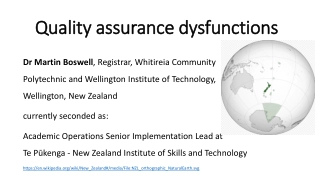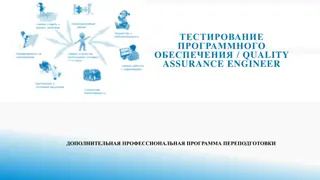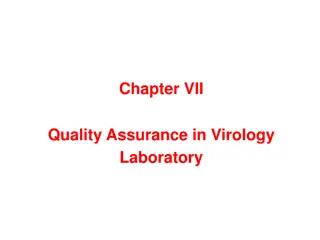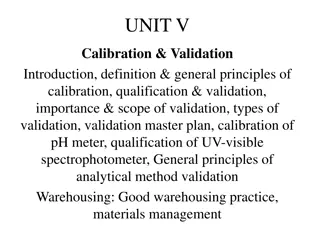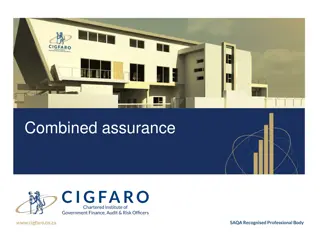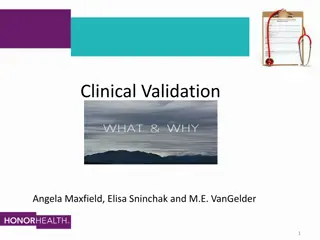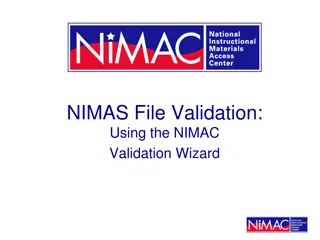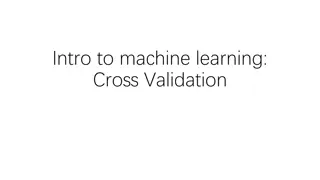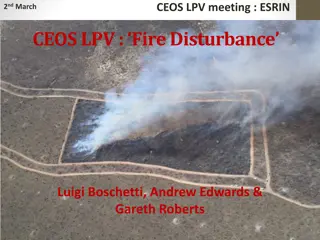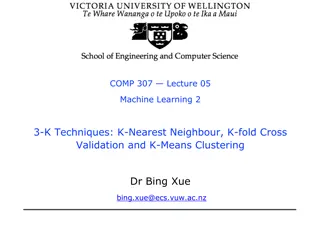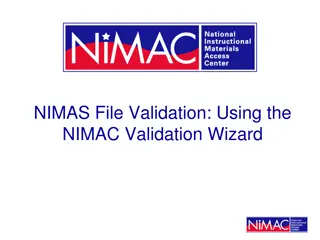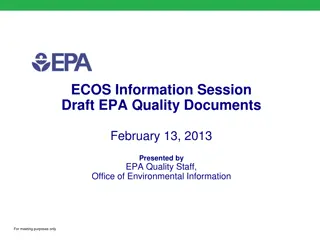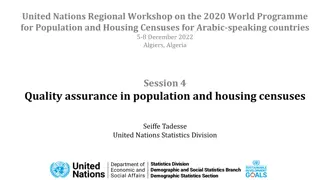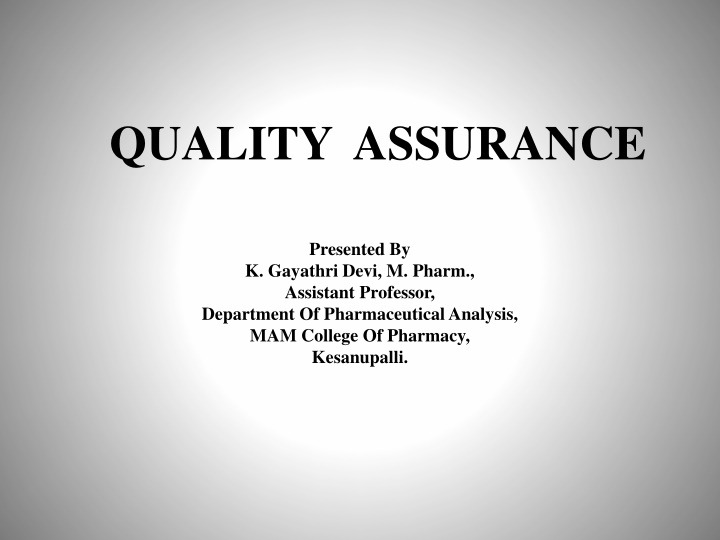
Quality Assurance in Pharmaceutical Analysis - Best Practices
Quality assurance is crucial in ensuring pharmaceutical products meet customer expectations. This article by Assistant Professor K. Gayathri Devi highlights sources of quality variation, control measures, statistical quality control methods, and types of control charts in the pharmaceutical analysis field.
Download Presentation

Please find below an Image/Link to download the presentation.
The content on the website is provided AS IS for your information and personal use only. It may not be sold, licensed, or shared on other websites without obtaining consent from the author. If you encounter any issues during the download, it is possible that the publisher has removed the file from their server.
You are allowed to download the files provided on this website for personal or commercial use, subject to the condition that they are used lawfully. All files are the property of their respective owners.
The content on the website is provided AS IS for your information and personal use only. It may not be sold, licensed, or shared on other websites without obtaining consent from the author.
E N D
Presentation Transcript
QUALITY ASSURANCE Presented By K. Gayathri Devi, M. Pharm., Assistant Professor, Department Of Pharmaceutical Analysis, MAM College Of Pharmacy, Kesanupalli.
QUALITY ASSURANCE Is the process of verifying or determining whether the products or services meet or exceed the customer expectations. SOURCES OF QUALITY VARIATION 1. 2. RAW MATERIAL: Selection, processing and extraction, e.t.c IN PROCESS VARIATION: During Mfg process, mixing, content uniformity, weighing, e.t.c PACKAGING MATERIAL: Selection of packaging material with respect to product. LABELLING: Errors during giving of labelling instructions, improper labelling. FINISHED PRODUCT: Storage of finished product, dispatch, e.t.c MANUAL ERROR: All the above may due to manual power. 3. 4. 5. 6.
CONTROL OF QV 1. RAW MATERIAL CONTROL: Two groups 1. Active/therapeutic 2. Inactive/inert Selection of good raw material, maintain specifications in precise terminology. Maintain details of test methods, instruments used and manner of sampling, e.t.c. Sampling according SOP only, qualify control test, storage conditions and maintain batch no, lot no, material name, e.t.c. The preserved sample should be retained for at least 7 years. IN PROCESS ITEMS CONTROL: Maintain FDP-CGMP guidelines to avoid contamination, errors, IPQA run to assess purity and quality uniformly. Steps to be followed: 1. QA before start-up: Environmental and microbiological control and sanitation; raw materials and Mfg equipment. 2. QA at start-up: Raw material processing; compounding; packaging materials control; labels control; finished product control. 3. MFG VARIATION CONTROL: Monitoring environmental conditions under which products are Mfd or stored. Monitoring of air and water systems to prevent contamination. Air handling units. Monitoring of personnel. Feedback and follow-up. 2.
STATISTICAL QC Definition: As an economic and effective system of maintaining and improving the quality of outputs through the whole operation process of specification, production and inspection based on continuous testing with random samples. METHODS OF QUALITY CONTROL 1. Control Chart 2. Acceptance sampling techniques 1. Control Chart: A statistical chart used for controlling Mfg process, is a graphical method consists of three different lines. A. Central line B. Upper control limit C. Lower control limit Functions: To signal the presence of assignable causes of variation. To give the evidence if a process is operating in a state of statistical control. Control chart purpose: Show the data changes, show the causes of changes in data. May be assignable changes or causes (Data outside control limits or trend in data), natural causes (Random variations around average).
TYPES OF CONTROL CHARTS: 1. Variable Charts 1. Variable Charts: R&X Chart 2. Attributes charts: P&C Chart a. R Chart: Worn bearing, a loose tool, An erratic flow of lubricant to machine, Sloppiness of machine operator. b. X Chart: Due to tool wear, increase in temp..., different methods used in the second shift, new storage material. c. P Chart: Nominally scaled categorised data; good-bad. d. C Chart: Discrete quantitative data, shows no of non conformities in a unit. ACCEPTANCE SAMPLING TECHNIQUES To determine whether an incoming lot of a product meets specified standards. Based on random sampling technique. 2. Attributes charts
Advantages More economical (fewer inspectors and less handling) Upgrades the inspection Applies to destructive improvement. Dis Advantages Certain risk of not accepting conforming lots and accepting non conforming lots. More time and effort is devoted to planning and documentation. Less information is provided about the product. There is no assurance that the entire lot conforms to specification. stronger motivation for
Good Laboratory Practices (GLP) for Pharmaceuticals and other Quality Control Laboratories What is Good Laboratory Practice (GLP?) Good Laboratory Practice contains a set of principles that provides a framework within which laboratory studies (Activities) are planned, performed, monitored, recorded, reported and archived. GLP help assure regulatory authorities that the data submitted are a true reflection of the results obtained during the study and can therefore be confidence upon when marking risk/safety assessment. Why GLP is Important in Pharmaceuticals Good Laboratory Practice contains different principles which are designed to ensure and promote consistency, quality, safety, reliability and integrity of chemicals during non-clinical and laboratory testing.
HISTORY Good Laboratory Practices (GLP) was first introduced in New Zealand and Denmark in 1972, and later in the US in 1978. It was followed a few years later by the Organization for Economic Co- operation and Development (OECD) Principles of GLP in 1992 & the OECD has since helped promote GLP to many countries. GLP is not only limited to chemicals but also it applies to medical devices, food additives, food packaging, colour additives pharmaceutical products or ingredients as well. and other non-
Basic Rules of GLP 1. 2. 3. Make sure to have the correct written instructions before starting a task. Do not carry out task for which you have not been trained. Keep records of information, results and actions taken. Make clear accurate records of what was done. Check that the instrument/ equipment/material used are clean, calibrated and correct ones as per procedure. Always notify if labels are seen either detached or appear to incorrect or are in wrong place. Never remove a label which has been incorrectly applied and never stick a new label over an old one of the same type. If label is incorrectly affixed strike it off, sign and paste new correct label adjacent to it Clean the glassware drying oven, refrigerator, walk in chamber incubators, water bath of the instruments like dissolution tester, disintegration testers etc, used in the quality control laboratories per the procedure. Clean the work benches after completion of work or at the end of the day whichever is earlier and keep the respective specification, General test procedure (GTP), Standard test Procedure (SOP s) etc used back to the designated place. While closing the Quality Control Laboratory, ensure that all water taps, instruments (which are not running), equipments, computers are put OFF . Put off the lights, AC s and closes the department. 4. 5. 6. 7. 8. 9.
Components of GLP 1.Premises and Utilities 2. Personnel 3. Training 4. Instruments/Equipments/Accessories 5. Validation/Verification of analytical methods 6. Testing and reporting 7. Stability studies 8. Chemicals, reagents, glassware and analytical standards 9. Documentation
Good Laboratory Practices (GLP) in terms of A to Z A Aprons/Analyst N Note books/Nose masks B Balances O Observations/OOS C Calibration/Chemicals P Procedures D Documentation Q Qualification E Entry & Exit R Reagents F Fume Hood S Safety/Solutions G Glassware T Training/Testing H Health/Hygiene U Upkeep I Instrument/Incidence V Validation J Justification W Weighing K Knowledge X X-ray diffraction L Logbooks/Laboratory Y Your Lab M Methods/Micro Z Zero Error
Results of Not following GLP in Laboratory Accident/Incident & Health Hazards Wrong/error in volume or weight measurement which may leads to wrong results. May leads to Instrument errors/Malfunctions Contamination of sample, reagent & solvent which may affect the product quality to be tested. Waste of time due to investigation of unexpected cause. Increase cost due to repetition & investigation Due to wrong result it may affect patient safety. Regulatory agency may take action results in warning letter, import alert etc. No evidence or documented proof of data generated
Conclusion Everyone makes mistakes that s why GLP is needed. GLP principles are a good idea even if you are not required to follow the standards. There are some simple rules such as : Say What You Do (with written standard operating procedures), do what you say (follow the procedures), be able to prove it (with good record keeping). The principles of good laboratory practice (GLP) is to support the development of quality and validity of test data used for determining the safety of chemicals and chemicals product. Hence GLP aims to decrease the occurrence of mistakes or mix- ups through large and specific labelling requirements. So every analyst those who are working in Quality control or in other testing laboratory should follow GLP.
VALIDATION Definition : Validation is the documented act of proving that any procedure, process, equipment, material, activity or system actually leads to the expected result. ISO definition : Validation is the confirmation by examination and the provision of objective evidence that the particular requirements for a specific intended use are fulfilled. According to the Food and Drug Administration (FDA), the goal of validation is to: establish documented evidence which provides a high degree of assurance that a specific process will consistently produce a product meeting its predetermined specifications and quality attributes.
NEED OF VALIDATION Before introduction of a new method into routine use. Whenever the conditions change for which a method has been validated, e.g., instrument with different characteristics. Whenever the method is changed, and the change is outside the original scope of the method.
Purpose of Validation To accept an individual sample as a member of a population under study. To admit samples to the measurement process. To authenticity. minimize later questions on sample To provide an opportunity for resampling when needed.
Advantages of validation During the process the knowledge of process increases. Assures the repeatability of the process. Assures the fluency of production. Assures that the product is continuously according to the marketing authorization. Decreases the risk of the manufacturing problems. Decreases the expenses caused by the failures in production. Decreases the risks of failing in GMP. Decreases the expenses of the every day production even though the validation itself will create expenses.
Scope of validation Validation requires an appropriate and sufficient infrastructure including: - organization, documentation, personnel and finances. Involvement of management and quality assurance personnel. Personnel with appropriate qualifications and experience. Extensive preparation and planning before validation is performed. A specific programmed for validation activities in place.
Validation done in a structured way according to documentation including procedures and protocols. Validation should be performed: for new premises, equipment, utilities and systems, and processes and procedures; at periodic intervals; and when major changes have been made. Validation in accordance with written protocols. A written report on the outcome to be produced. Validation over a period of time, e.g. at least three consecutive batches (full production scale) to demonstrate consistency. (Worst case situations should be considered.) Demonstrate suitability for new manufacturing formula or method. Process, materials and equipment to prove consistent yield of a product of the required quality. Manufacturers to identify what validation work is needed. Significant changes (facilities, equipment, processes) - should be validated Risk assessment approach used to determine the scope and extent of validation needed.
MAJOR PHASES OF VALIDATION 1.PREVALIDATION QUALIFICATION ( PHASE 1) 2.PROCESS VALIDATION (PHASE 2) 3.VALIDATION MAINTAINANCE (PHASE 3) PREVALIDATION QUALIFICATION PHASE This includes all activities relating to product research and development , pilot batch studies, scale up studies, commercial scale batches, establishing stability conditions and storage and analysis of in process and finished dosage forms, equipment qualification, installation qualification, master production document, operational qualification and process capacity.
PROCESS VALIDATION PHASE In this phase the limits of all critical process parameters are established, verified and validated to ensure that the desired quality of product can be achieved even under the worst condition. VALIDATION MAINTAINANCE PHASE This includes review of all documents related to process validation of audit reports, to make sure that no changes, deviations, standard operating procedures including change control procedures have been followed . Hence there is no need for requalification and revalidation.
PROTOCOLS OF VALIDATION Protocols should specify the following in details. The purpose and scope of study. The purpose should already been clearly defined. The process equipment system or subsystem should be clearly and precisely defined and details of performance characteristics is to be studied. Installation and qualification requirement for new equipment should be done. Where existing equipment requires up gradation with proper justification for the change(s) and statement of qualification requirement. Stepwise details statement of action to be taken in performing the study. Responsibility for performing the study to be assigned. Statement on all test methodology to be employed with a precise statement of the test equipment or material to be used. Calibration of test equipment is required. References to any relevant standard operating procedures. Requirement for the current format of the report on the study. Acceptance criteria against which the success of the study is to be calculated.
Validation Master Plan (VMP) A Validation Master Plan is a document that summarizes the firm's overall philosophy, intentions and approach to be used for establishing performance adequacy. The Validation Master Plan could consist of: Approval page and table of contents Introduction and objectives Facility and process description Personnel, planning and scheduling Responsibilities of committee members
Process control aspects Equipment, apparatus, processes and systems to be validated Acceptance criteria Documentation e.g. validation protocols and reports, SOPs, etc. Training requirements
CONTENTS A. Introduction to validation policy, scope, location and schedule. B. Organizational structure with response to personnel and responsibilities. C. Plant / process /production description mentioning rationale for inclusion or exclusion, extend of validation. D. Specific process considerations that are critical & require extra attention. E. List of products/processes/systems to be validated summarized in a matrix format , validation approach F. Revalidation activities, actual status and future planning. G. Key acceptance criteria H. Documentation format I. Reference to required SOPs J. Time plans of each validation project and sub project.
TYPES OF VALIDATION The major types of Validation : PROCESS VALIDATION CLEANING VALIDATION EQUIPMENT VALIDATION VALIDATION OF ANALYTICAL METHODS 1. PROCESS VALIDATION Definition As per FDA Nov.2008, The collection of data from the process design stage throughout production, which establishes scientific evidence that a process is capable of consistently delivering quality products. Types of Process validation: Prospective validation. Retrospective validation. Concurrent validation. Revalidation.
Prospective validation carried out during the development stage by means of a risk analysis of the production process, which is broken down into individual steps. These are then evaluated on the basis of past experience to determine whether they might lead to critical situations. Where possible critical situations are identified, the risk is evaluated, the potential causes are investigated and assessed for probability and extent, the trial plans are drawn up, and the priorities set. Concurrent validation carried out during normal production This method is effective only if the development stage has resulted in a proper understanding of the fundamentals of the process. The first three production-scale batches must be monitored as comprehensively as possible. The nature and specifications of subsequent in-process and final tests are based on the evaluation of the results of such monitoring. his careful monitoring of the first three production batches is sometimes regarded as prospective validation. Concurrent validation together with a trend analysis including stability should be carried out to an appropriate extent throughout the life of the product.
Retrospective Validation Retrospective validation involves the examination of past experience of production on the assumption that composition, procedures, and equipment remain unchanged such experience and the results of in-process and final control tests are then evaluated. Recorded difficulties and failures in production are analyzed to determine the limits of process parameters. Revalidation Revalidation is needed to ensure that changes in the process and/or in the process environment, whether intentional or unintentional, do not adversely affect process characteristics and product quality. Revalidation may be divided into two broad categories: Revalidation after any change having a bearing on product quality. Periodic revalidation carried out at scheduled intervals.
2. CLEANING VALIDATION DEFINITION: A process of attaining and document in sufficient evidence to give reasonable assurance, given the current state of Science and Technology, that the cleaning process under consideration does, and / or will do, what it purpose to do. Objective To minimize cross contamination. To determine efficiency of cleaning process. To do troubleshooting in case problem identified in the cleaning process and give suggestions to improve the process 3. EQUIPMENT VALIDATION DEFINITION As per FDA, May 1987, Action of proving that any equipment works correctly and leads to the expected result is equipment qualification . It is not a single step activity but instead result from many activities.
VALIDATION OF ANALYTICAL METHODS Definition : The process by, which it is established, by laboratory studies, that the performance characteristics of the method meet the requirements for the intended analytical application . Accuracy : The closeness of test results obtained by that method to the true value. This accuracy should be established across its range. Precision: "The degree of agreement among individual test results when the method is applied repeatedly to multiple sampling of a homogenous sample. Linearity Robustness Ruggedness Limit Of Detection Limit Of Quantification
Validation of Analytical Instruments & calibration UV-Visible Spectrophotometer Wave length Stray light Resolution Power Noise Stability Photometric accuracy Linearity IR Spectrophotometer Spectrofluorimeter HPLC Flow rate Accuracy Gradient Accuracy System Precision Wavelength Accuracy Detector Linearity Column oven temperature Accuracy HPTLC Spotting and Detection Capacity GC Flow rate Accuracy Column oven temperature Accuracy System Precision Detector noise and Drift Test
UV-Visible Spectrophometer 1. Wavelength Accuracy: As the deviation of the wavelength reading at an absorption band or emission band from the wavelength of the band. Test: By comparing the recorded wavelength of the peak against the value of reference standard. Acceptance Criteria: UV: 200-380nm, Visible: 380-800nm. 2. Stray Light: The detected light of any wavelength that is outside the band width of the wavelength selected. Test: Three test solutions prepared and measured the stray light at 200, 220 & 340nm. Acceptance Criteria: The transmittance of the solution in a 1CM cell should be less than 0.01 or the absorbance value should be greater than 2. 3. Resolution Power: The resolution of a UV-Visible spectrophotometer is related to its spectral band width. The smaller the spectral width, the finer the resolution. The spectral band width depends on the slit width and the dispersive power of the spectrophotometer. Test: 0.02%V/V toluene in hexane is used. The Abs measured at 269nm & 266nm. Acceptance Criteria: The ratio of the Abs at 269 & 266 nm > 1.5.
4. Noise: Measurement affects the accuracy at both ends of the Abs scale. Photon noise 4m the light source affects the accuracy of the measurements leads to low Abs. Test: Air is scanned in the Abs mode for 10min. Peak to noise is recorded at 500nm. Root mean square noise is then calculated. Acceptance Criteria: Root mean square noise should be less than 0.001AU. 5. Baseline Flatness: Demonstrates the ability of the instrument to normalize the light intensity measurement and the spectral output at different wavelength throughout the spectral range. Test: Air is scanned in the Abs mode. The highest and lowest deflections in the Abs unit are recorded. Acceptance Criteria: The deflection is typically less than 0.01AU. 6. Stability: The lamp intensity is a function of the age of the lamp temperature fluctuations and wavelength of the measurement. These changes can lead to errors in the value of the measurements over an extended period of time. Test: Air is scanned in the Abs mode for 60min at specific wavelength. The highest and lowest deflections in the absorbance unit are recorded. Acceptance Criteria: The deflection is typically less than 0.002AU/h.
7. Photometric Accuracy: By comparing the difference between the measured absorbance of the reference materials and the established value. Test: Either neutral density filters or potassium dichromate solution are used. Acceptance Criteria: 6 replicate measurements of the 0.006%w/v potassium dichromate solution at 235, 257, 313 and 350nm should be less than 0.5% RSD. 8. Linearity: The linear dynamic range of the measurements are limited by stray light at high absorbance and by noise at low absorbance. The accuracy of the quantification of the sample depends on the precision and linearity of the measurements. Test: A series of potassium dichromate solutions of conc...20,40,60,80 and 100mg/L in 0.005M H2SO4. The absorption of various wavelengths are plotted against the conc... Of the solution and the correlation coefficients are calculated. Acceptance Criteria: Correlation coefficients > 0.999.
IR SPECTROPHOTOMETER Prepare polystyrene film with thickness 0.04nm and verify the wave number. SPECTRO FLUORIMETER Sensitivity of the instrument is checked by using primary standard solution, 1ppm solution of quinine sulphate solution in 0.1M H2SO4. Primary wavelength set at 266nm and check the sensitivity of the instrument. HPLC 1. Flow Accuracy: The performance of the pump module is the ability to maintain accurate and consistent flow of the mobile phase. Poor flow rate will affect the retention time and resolution of the separation. Test: The flow rate accuracy at 2ml/min can be verified by using a calibrated stopwatch to measure the time it takes to collect 25ml of effluent from the pump into a 25ml volumetric flask. Acceptance Criteria: 2% of the set flow rate. 2. Gradient Accuracy: The accuracy and linearity of the gradient solvent delivery can be verified indirectly by monitoring the absorbance change when the composition of the two solvents from two different channels changes. Test: Channel A is filled with a pure solvents such as methanol and channel B is filled with a solvent containing UV active tracer such as caffeine. Acceptance Criteria: The linearity of the gradient delivery can be verified by the plotting the Abs at various mobile phase compositions versus sample compositions. 3. System Precision: Weigh accurately 60mg of caffeine into 100 ml volumetric flask, dilute to the volume with mobile phase. Transfer 10ml of this solution into 100ml flask and makeup with mobile phase. Inject blank followed by standard preparation in 6 replicates. Note down the areas and retention times. Acceptance Criteria: The %RSD of retention time and peak area should be <1%.
4. Wavelength Accuracy: Inject blank followed by standard preparation and note down the height or absorbance. Acceptance Criteria: The maximum absorbance should be 2nm. 5. Detector Linearity: The linearity of the detector response can be checked by pumping or by filling the flow cell with a series of standard solution of various concentration. Aqueous caffeine solutions are convenient for the linearity measurement. The correlation coefficient between sample concentration and response can be calculated to determine the linearity. Acceptance Criteria: R>0.999 6. Column oven temperature accuracy: The efficiency of HPLC column varies with column temperature. The temp... Accuracy of the column heater is evaluated by placing a calibrated thermometer in the column compartment to measure the actual compartment temperature. The thermometer readings are compared to the present temperature at 40and 60 degree centigrade. Acceptance Criteria: The resulting oven temperature from the thermometer display should be within plus or minus 2 degree centigrade of the set temperature.
HPTLC Spotting and detection capacity: Procedure: Spot 5micro litre of each solution observe at 254nm, 366nm. Preparation of stock solution: Stock solution-I: Weigh 500mg of sodium salicylate in 250ml of volumetric flask dissolve and dilute with 96%v/v alcohol. Stock solution-II: Weigh 100mg of sodium salicylate in 250ml of volumetric flask dissolve and dilute with 96%v/v alcohol. Acceptance Criteria: The spotsshall be comparable intensity wise. Spot due to Stock solution-II shall be visible at 254nm. Spot due to Stock solution-I shall be visible at 366nm. GC 1. Flow Rate Accuracy: Connect the digital flow meter to the detector outlet port. Set the carrier gas flow and wait till it reaches the set flow. Note the observed flow in replicate. Repeat the procedure for other carrier gases such as hydrogen and air. Acceptance Criteria: The flow rate of carrier gas should be 10% of set flow.
2. Column oven temperature accuracy: Place the thermometer in the column oven and set the column oven temperature at 40degree centigrade. Wait till the temperature stabilizes. Note the observed temp...over a period of 10mts. Repeat the procedure for 100, 150 and 190 degree centigrade. Acceptance Criteria: The resulting oven temperature from the thermometer display should be within 2 degree centigrade of the set temperature. 3. System Precision: Transfer 20ml of methanol, ethanol and acetone into 100ml volumetric flask and make up with ethyl acetate. Inject blank followed by standard preparation in 6 replicates. Note down the areas and retention times. Acceptance Criteria: The %RSD of retention time should be not more than 1% and peak area NMT 5%. 4. Detector noise and Drift test: After GC is ready run the system up to 15mts through single run. After completion of run calculate noise and drift through software. Acceptance Criteria: Noise NMT 100mcgV; Drift NMT 2500mcgV/hr.
Regulatory Control in Pharmaceutical Analysis Introduction Drugs play an important role in the health of both people and the economy of a country. Pharmaceutical drugs are available from a large number of sources. People and Governments willing to spend money on drugs for many reasons so, it must be safe, effective and good quality and used appropriately. This means, in turn, that development, production, importation, exportation distribution of drugs must be regulated to ensure that they meet prescribed standards. and subsequent
Regulatory requirements In an ideal world, the need for analysis should be driven by the desire to assure the quality of a drug product. However, in the real world the need for pharmaceutical drug analysis is driven largely by regulatory requirements. A team consisting of R&D, QC, and QA unit members develops these quality and compliance systems. It should be one of the highest priorities of top management and QA units to develop and monitor these systems to comply with the cGMP and GLP expectations.
Key function of regulatory agencies Product registration authorization, and monitoring of drug efficacy and safety) Regulation of drug manufacturing, importation, and distribution Regulation & Control of drug promotion and information. Adverse drug reaction (ADR) monitoring. Licensing of premises, persons and practices. Goal of regulatory agency Main goal of drug regulation is to guarantee the safety, efficacy and quality of drugs available to public. (drug evaluation and
The drug regulation Drug Laws rug Regulatory Agencies Drug Regulatory Boards Quality Control Drug Information Centers etc. Drug regulatory system in India Drugs and Health is in concurrent list of Indian Constitution. It is governed by both Centre and State Governments under the Drugs & Cosmetics Act, 1940. MAIN BODIES Central Drug Standard Control Organization (CDSCO) Ministry Of Health & Family Welfare (MHFW) Indian Council Of Medical Research (ICMR) Indian Pharmaceutical Association (IPA) Drug Technical Advisory Board (DTAB) Central Drug Testing Laboratory (CDTL) Indian Pharmacopoeia Commission (IPC) National Pharmaceutical Pricing Authority (NPPA)
WELL DEFINED DRUG REGULATORY SYSTEM (Govt. of India) Ministry of health and family welfare DGHS DTAB DCGI CDSCO Enforcement & GMP audit Division Quality Control Division CDTL Registration Division New Drug Division Pharmacovigilance Trainings
Central Drug Standard Control Organization CDSCO Head quarters New Delhi North Zone Ghaziabad West Zone Mumbai South Zone Chennai East Zone Kolkata. Other zonal offices Ahmedabad and Hyderabad. Sub-Zonal Office 2 Port offices/Airports 7 Laboratories 6
Functions undertaken by Central Government Statutory function: Laying down standards of drugs, cosmetics, diagnostics and devices. Laying down regulatory measures, amendments to Acts and rules. To regulate market authorization of new drugs. To regulate clinical research in India. To approve licenses to manufacture certain categories of drugs as Testing of drugs by Central Drugs Labs. National Institute of Health and Family Welfare NIHFW is an Apex Technical Institute, funded by Ministry of Health and Family Welfare, for promotion of health and family welfare programmers in the country through education, training, research, evaluation, consultancy and specialized services.
ACTIVITIES AND RESPONSIBILITIES Measuring weight of children to assess the nutritional status. Assessment of diseases like level of anemia. Testing of food material like cooking salt for level iodine. To release fund on the advice of the Ministry. It is responsible for all governmental programs relating to family planning in India.


